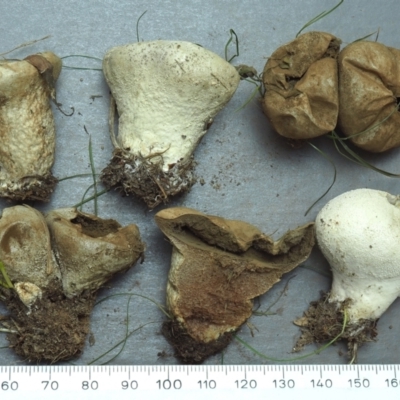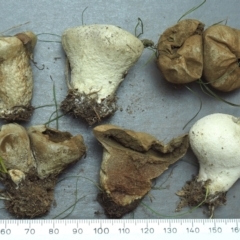Lycoperdon pratense (Meadow Puffball)
The fruitbody is a puffball. When mature it is often a little flat-topped and hence somewhat like a truncated, upside-down cone (or is slightly pear-like) and may measure up to 5 centimetres across. It starts off white (with a coating of very short pyramidal spines and granules over the thin and flexible skin) but becomes brown with age. The spines and granules tend to disappear with age but some may persist, especially on the lower parts of the fruitbody. When mature the fruitbody consists of two parts; the upper holds a mass of powdery, brown spores in a fibrous, cotton-wool-like mesh and the lower consists of a well-developed supporting base. The base is compressible and consists of numerous empty cells and, internally, has a superficial resemblance to solidified foam. A thin membrane (or diaphragm) separates the upper and lower parts. A hole develops at the top and with age it expands to become a very broad opening through which the spores can escape.
It is found on the ground in open areas, e.g. grasslands, grassy woodlands, lawns and sportsgrounds
The species was previously known as Vascellum pratense and has been reported from many countries.
Look-alikes
The combination of the well-developed sterile base, the large opening and the presence of a diaphragm makes mature specimens distinctive. Other puffballs may show one or other of those features, but not all three. The diaphragm is the most useful identification feature (and Calvatia fruitbodies have a diaphragm but the outer skin is thicker and cracks irregularly, before falling away to expose the spores).
You would not see theLycoperdon pratense diaphragm unless (1) the puffball is very old, with a large opening and with almost all spores having dispersed, so as to make it easy to see the smooth diaphragm through the opening or (2) you slice the puffball in half vertically so as to see it in cross-section.
Lycoperdon pratense is listed in the following regions:
Canberra & Southern Tablelands | South Coast
Species information
- Lycoperdon pratense Scientific name
- Meadow Puffball Common name
- Not Sensitive
- Cosmopolitan
- Unknown
- Up to 709.7m Recorded at altitude
- Machine learning




